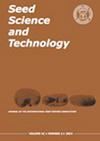一种提高野生pennyweed品种发芽的过程
IF 3
4区 农林科学
Q2 AGRONOMY
引用次数: 0
摘要
pennyweed是一种新兴的油籽作物,但一些改良品系仍然表现出种子休眠,这可能阻碍发芽和建立。2021年进行了一项实验室研究,以确定提高野生pennyress改良系(' MN106NS ')发芽的种子处理。采用随机完全区组试验设计,2个重复,12个种子处理:未处理对照;氟菌腈(50µg / g种子);赤霉素(GA)以0.05或0.01% w/w浸泡12小时;用硅藻土和商业粘合剂制粒±每种先前成分和巴西棕榈蜡涂层。在所有处理中,测试了颗粒处理的均匀性和稳定性,并对发芽时间(20°C黑暗条件下3至14天)进行了量化。颗粒化处理籽粒的重量和大小均有增加(平均增加142%,增加29%),颗粒化组合处理籽粒的稳定性没有变化。除单独添加氟菌腈外,所有种子处理的总发芽率均高于对照。虽然所有的制粒处理都能提高总发芽率,但GA作为浸渍处理或在制粒过程中添加对MN106NS的发芽率最有效。本文章由计算机程序翻译,如有差异,请以英文原文为准。
A process to enhance germination of a wild pennycress variety
Pennycress is an emerging oilseed crop, but some improved lines still exhibit seed dormancy that may impede germination and establishment. A laboratory study was conducted in 2021 to identify seed treatments to increase germination of a wild pennycress improved line (‘MN106NS’). A randomised complete block experimental design was used with two replications and 12 seed treatments: untreated control; fludioxonil (50 µg ai per g of seed); gibberellic acid (GA) soak at 0.05 or 0.01% w/w for 12 hours; pelleting with diatomaceous earth and a commercial binder ± each prior component and a carnauba wax coating. For all treatments, uniformity and stability of pelleted treatments were tested, and germination over time (3 to 14 days at 20°C in dark) was quantified. There were consistent increase, in weight and size (142% in weight and 29% in size on average) of seeds with pelleting, and pelleting combination treatments did not vary in stability. Total germination increased compared to the control with all seed treatments, except the addition of fludioxonil alone. While all pelleting treatments improved total germination, the use of GA as a soak treatment or as an addition during seed pelleting was most effective to increase germination in MN106NS.
求助全文
通过发布文献求助,成功后即可免费获取论文全文。
去求助
来源期刊

Seed Science and Technology
农林科学-农艺学
CiteScore
3.00
自引率
28.60%
发文量
36
审稿时长
>36 weeks
期刊介绍:
Seed Science and Technology (SST) is an international journal featuring original papers and articles on seed quality and physiology related to seed production, harvest, processing, sampling, storage, genetic conservation, habitat regeneration, distribution and testing. A journal that meets the needs of researchers, advisers and all those involved in the improvement and technical control of seed quality. Published every April, August and December.
 求助内容:
求助内容: 应助结果提醒方式:
应助结果提醒方式:


